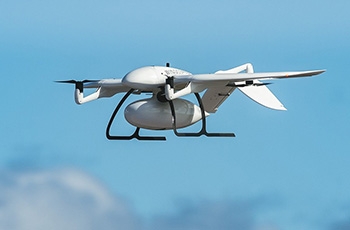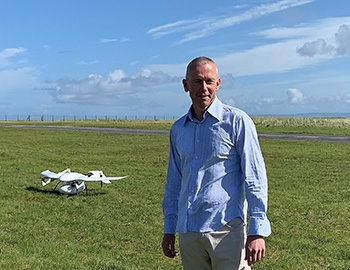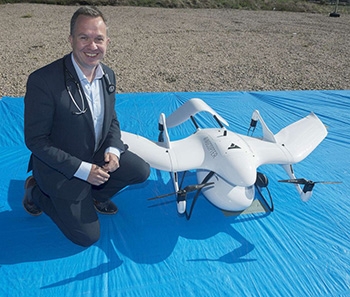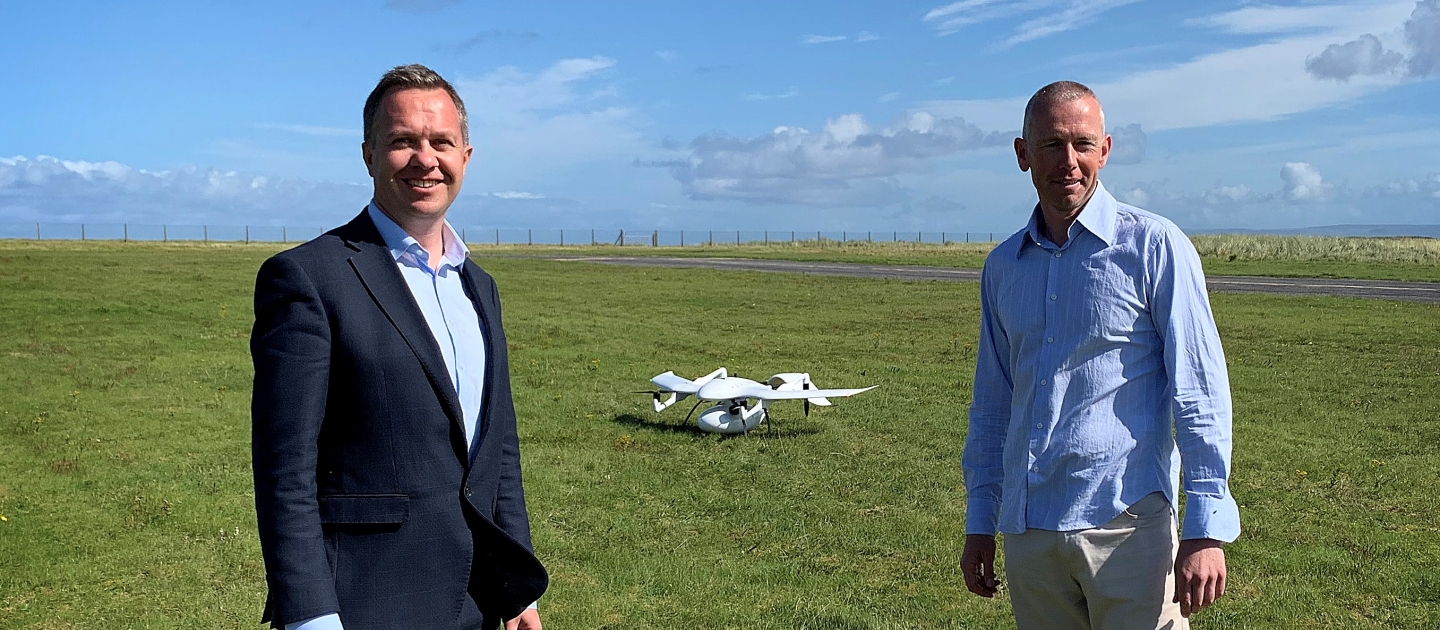From a conversation around a coffee table, to flying a drone, off-shore, laden with medication to the Aran Islands, a concept was proven for researchers who have described the project’s initial success as being a keystone moment for patient care. Why would this be the case?
Because the next wave of this project will see collaborating researchers from University of Limerick and NUIG extend the proof of concept into the use of drones to deliver medication and ultimately look to bringing an improvement to patient care for housebound people in the aftermath of severe weather.
Collaborating with Professor Derek O’Keefe at NUI Galway, University of Limerick senior AV technician Dr Kevin Johnson told UL Links that “the project started in late Spring 2018 around a coffee table where a seed of a thought came to life and a plan was formed.
“While meeting Professor O’Keeffe NUIG to discuss project collaborations, he mentioned that he was interested in using a drone to deliver medications to patients with diabetes after severe weather events. This was because in October 2017,
Storm Ophelia (Cat 3 Hurricane) had caused widespread post storm flooding and early Spring 2018 Storm Emma (Blizzard) had caused snowdrifts. Therefore many of Professor O’Keeffes patients with diabetes were left housebound and unable to attend their clinic and were concerned about running low on their insulin, a live saving medication. A novel way of delivering insulin to patients was needed in case a more severe, sentinel weather event occurred in the future.”
Kevin told UL Links that he was just back from a trip to Scoresby Sound in East Greenland where he was filming humpback whales with a drone.
“One of Greenland’s biggest summer guests is the humpback whale which comes like a migratory bird in the month of May and swims in the larger fjords along the coast until October, when it swims back to more southern climes.
“I was on board a schooner for several days and then travelled to West Greenland and Ilulissat and based myself there. The next four days were spent doing day and evening trips looking for humpbacks again and trying to capture some aerial photography and videos of these magnificent animals.
“Based on this drone adventure and my experienced gained, Professor O’Keeffe consulted with me regarding the technological advances of unmanned aerial vehicles over the last several years and the current state of the art.
We discussed the possibility of sending a package to a remote island location and that was the start of the project #DiabetesDrone.
The flight involved a vertical take-off and landing (VTOL) drone delivery of diabetes prescription medications (insulin, glucagon) and collection of a patient blood sample (HbA1c) between Connemara Airport and Inis Mór, Aran Islands.
The launch team had a live FPV (first-person view) camera feed from the aircraft to ensure a visual from the drone once it flew beyond visual line of sight for safety. The second team on Inis Mór, Aran Islands, had a second ground control station with satellite telecoms so they could monitor the location of the drone to the destination, at the local airfield.

The drone supplied by Survey Drones Ireland was a Wingcopter 178 Heavy Lift, with insulated parcel delivery box for the payload, an all-electric vertical take-off and landing drone that transitions into a very efficient forward flight once up in the air. It reaches destinations of up to 100km distance in less than an hour.
The project was run in partnership with several industry experts and stakeholders including, Skytango, Survey Drones Ireland, Wingcopter, Vodafone Ireland and global healthcare company Novo Nordisk.
Dr Marion Broderick, General Practitioner on the Aran Islands, said: “Drone delivery helps connectivity for island communities and has endless possibilities.”
Marion Hernon, a patient with Diabetes on the Aran Islands, said: “Insulin is essential for my survival and having a diabetes drone service in an emergency situation would ensure this survival while living on an offshore island.”
Back to the project details and Dr Johnson explained that one of the main concerns with regard to the project was regulations and adhering to the rules set down by the IAA - Irish Aviation Authority.
“The IAA gave us a special dispensation to allow this research to take place and conduct a beyond visual line of sight (BVLOS) autonomous drone flight. The flight is being used as part of the academic research work into the use of drone technology to improve patient care.”
Dr Johnson (pictured right) added that the successful flight will also form part of wider research into drone corridor planning via radio frequency network mapping.
“A major issue with the telecommunication masts that are deployed along the flight path is that the antenna all point down towards the ground and transmit their signal there. However the drone is flying above the masts - in our case at approximately 120 metres above sea level - and there is little or no signal available.

“Our project telecommunications partner Vodafone had to work with the team and modify the masts to guarantee coverage for the drone along the flight corridor. This is something that will need to be taken into consideration going forward with drone deliveries,” Dr Johnson explained.
This is not the first time drones have been used to deliver essential medical supplies, with blood, defibrillators and human organs for transplant all transported by drone. However, it is the first time the technology has been used to deliver diabetes medication autonomously and beyond the visual line of sight.
“It’s the whole cycle of care,” Prof O’Keeffe said. “We did it in a highly regulated area of the EU.”
“This is the keystone moment,” Prof O’Keeffe said. “We’ve shown it can be done safely with the right professionals.”
Looking at the future of the project, Dr Johnson explained that now we have successfully completed the first vertical take-off and landing autonomous drone flight between the mainland and the Aran Islands (20km each way), our focus is switching to what we can do next in order to progress this innovative project.”

To that end, Prof O Keeffe and Dr Johnson plan to submit a grant to a funding body with a focus on extending the proof of concept idea and working with the relevant organisations and bodies to make this service a reality to improve patient care.
See more at www.diabetesdrone.com and on Twitter @DiabetesDrone #DiabetesDrone
- Andrew Carey
